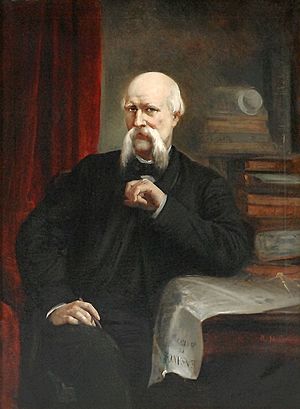Ildefons Cerdà facts for kids
Ildefons Cerdà i Sunyer (Catalan pronunciation: [ildəˈfons səɾˈða i suˈɲe]; Spanish: Ildefonso Cerdá Suñer; 23 December 1815 – 21 August 1876) was a Spanish urban planner and engineer. He is famous for designing the "extension" of Barcelona in the 19th century, known as the Eixample. Cerdà is seen as the founder of modern town planning. He even created the word "urbanization," which means the process of making an area more urban or city-like.
Contents
Biography of Ildefons Cerdà
Cerdà was born in Centelles, Catalonia, Spain, in 1815. He studied to become a civil engineer, which is someone who designs and builds things like roads, bridges, and buildings. He trained at a special school in Madrid.
After finishing his studies, he worked in different cities in Spain. In 1848, he moved to Barcelona and got married. When his brothers passed away, Cerdà inherited money from his family. This allowed him to leave his job as an engineer and focus on his interests. He became very interested in politics and studying how cities are planned.
Planning Barcelona's Expansion
At the time, Barcelona was a crowded city surrounded by old walls. These walls made it hard for the city to grow and led to problems like diseases spreading easily. People wanted the walls to be torn down. When the government finally agreed, Cerdà realized that the city needed a good plan for its expansion. He wanted the new part of the city to be efficient and a healthy place to live, unlike the old, crowded areas.
Since he couldn't find any good books or plans to help him, he decided to write his own. He also started designing what he called the Ensanche or Eixample. He took some ideas from other engineers but created a completely new and modern plan. His design was carefully thought out, not just made up on the spot.
Cerdà kept working on his projects and improving his designs throughout his life. He also developed his ideas to plan even larger areas, like entire regions. Sadly, he used all his family's money on his work. He died in 1876 with many debts and was never paid for his most famous work, the design of Barcelona's Eixample.
Cerdà's Achievements
Ildefons Cerdà was a very talented person. To achieve his vision for cities, he left his steady job as an engineer. He even ran for election and became a member of the Cortes, which is like the Spanish Parliament.
He wrote important new laws and created a detailed map of Barcelona's surroundings. He also wrote books about his theories to explain his major city planning projects. Cerdà even invented several important words in Spanish, including urbanización (urbanization).
Cerdà's Approach to City Planning
Cerdà focused on important needs for people living in cities. He believed homes needed plenty of sunlight, natural light, and fresh air. He was very influenced by the idea that good health depended on clean surroundings. He also thought it was important to have green spaces for people to enjoy.
He also focused on good ways to get rid of waste, including proper sewers. And he wanted people, goods, energy, and information to move smoothly through the city.
Designing the City Network
Cerdà's designs showed a way of thinking about cities as a network, which was very advanced for his time. His street layout and grid plan were made to work well for people walking, carriages, and horse-drawn trams. He even thought about future urban railway lines, which were not common yet.
His plans also included systems for gas supply and large sewers to stop frequent floods. He made sure to include public and private gardens and other important things. He used the newest technical ideas in his designs if they helped make the city better connected. He also came up with his own amazing new ideas. This included a smart system for land readjustment, which helped make his project successful. He also did a detailed study of how working-class people lived. He did this to show the problems caused by crowded living conditions.
Major Works by Cerdà
Cerdà wrote several important books and plans about his ideas:
- Teoría de la Construcción de Ciudades ("Theory of City Construction," 1859): He wrote this book to explain his first plan for the Barcelona Extension.
- Teoría de la Viabilidad Urbana y Reforma de la de Madrid ("Theory of Urban Roadspace and Reform of That of Madrid," 1861): This book supported his plans for improving the inner city of Madrid, the capital of Spain.
- Teoría del Enlace del Movimiento de las Vías Marítimas y Terrestres ("Theory of the Linkage of Movement on Landways and Seaways," 1863): This was for a plan to connect roads, railways, and sea transport at the port of Barcelona. Most of this book hasn't been found yet.
- Teoría General de la Urbanización ("General Theory of Urbanization," 1867): This book explained his 1859 project for the Barcelona Extension in more detail.
- Teoría General de la Rurización ("General Theory of Ruralization"): This book explored ideas about rural areas.
See also
 In Spanish: Ildefonso Cerdá para niños
In Spanish: Ildefonso Cerdá para niños
- Urban planning of Barcelona
Images for kids
-
Cerdà's gravestone, designed like his plan for Eixample in Barcelona.






